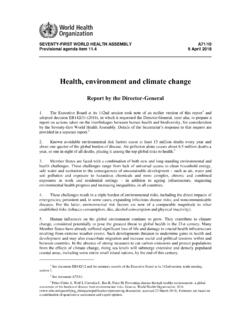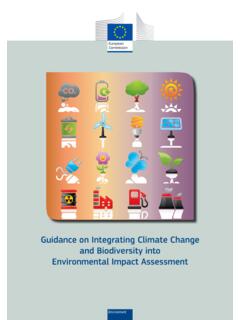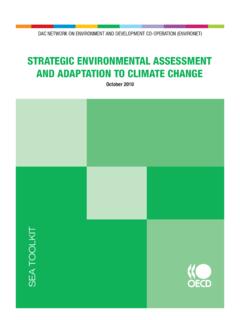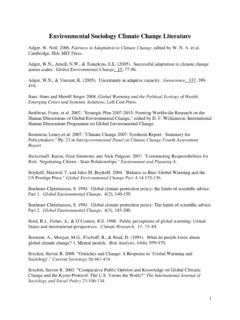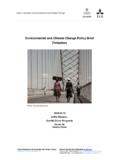Transcription of ENVIRONMENTAL AND CLIMATE CHANGE ISSUES IN THE ...
1 OECD Council Working Party on Shipbuilding (WP6) ENVIRONMENTAL AND CLIMATE CHANGE ISSUES IN THE SHIPBUILDING INDUSTRY NOVEMBER 2010 2 Summary This report examines a number of ENVIRONMENTAL , CLIMATE CHANGE and sustainable development (green growth) ISSUES that are affecting the shipbuilding industry. The report notes that like other heavy fabricating sectors shipbuilding involves the use of materials and manufacturing practices that can impact on the environment, can contribute to CLIMATE CHANGE . The report also points out that as well as the construction phase ships can have such impact throughout their lives (which can extend to 30 or more years), and during their disposal.
2 Taking a holistic approach to ship construction could give the shipbuilding industry the opportunity of not only setting its own ENVIRONMENTAL agenda (rather than be forced by government or public pressure) but to also deal with such impacts more effectively, and perhaps even benefit commercially from associated innovations. Action This report was considered by the Council Working Party on Shipbuilding at its meeting on 2-3 November 2010 3 ENVIRONMENTAL AND CLIMATE CHANGE ISSUES IN THE SHIPBUILDING INDUSTRY POLICY OVERVIEW Background 1.
3 This report was prepared for the Council Working Party on Shipbuilding by Mr. Karsten Olsen, a consultant who has worked at the OECD dealing with sustainable manufacturing ISSUES . Mr. Olsen has also prepared a similar report on behalf of the Steel Committee. Government and industry involvement 2. In recognition of the growing importance of ENVIRONMENTAL and CLIMATE CHANGE ISSUES in both government policy and commercial decision making, the Secretariat involved WP6 members, non-OECD economies, international organisations and industry in the project by seeking submissions on the study, so that it could reflect the situation facing the shipbuilding industry in the most accurate way possible.
4 3. While there were not a large number of responses, some submissions were received, and the Secretariat would like to express its appreciation to those respondents. Report Objectives 4. The broad objective of this project was to identify ISSUES related to the environment, CLIMATE CHANGE (and where appropriate green growth and sustainable development) that are relevant to the shipbuilding sector, and to discuss the implications of these for the industry. 5. The study addresses both the positive and negative aspects of the role of the shipbuilding industry on the environment, global climatic CHANGE and sustainable development, and the consultant was asked to address the following aspects: A broad description of the types of activities, materials emissions products and practices that could impact (positively or negatively) on the environment, CLIMATE CHANGE and sustainable manufacture.
5 An analysis of the impacts of shipyard activities on their immediate surroundings. An analysis of the impact of materials, components and practices used in the shipbuilding process (for example the carbon footprint associated with the production, transportation and final disposal of materials used in ship construction). Positive aspects of the shipbuilding industry that reduce or minimise the impact of their activities and products on the environment and CLIMATE CHANGE , and/or which support sustainable manufacturing.
6 4 Key Findings 6. The Secretariat suggests that the following are key findings of the report which may be greatest interest to the Working Party. While government and public attention is increasingly focused on the ENVIRONMENTAL , CLIMATE CHANGE and green growth impacts of industrial activities, there seems to be little apparent awareness of this in the shipbuilding sector, and there appears to be considerable reluctance by both governments and industry to discuss these ISSUES . There is very little publicly available information that relates specifically to the shipbuilding sector, that that while the problems and hazards associated with materials and practices used at shipyards are well known, the actual impacts of the shipbuilding activities are not.
7 The potential impact of emissions from shipbuilding operations on their immediate environment can be very significant, especially given that shipyards are inevitably near and on water, which increases the likelihood of propagation of some of those emissions. Ships are built to last for a very long time (up to 30 or more years) and their ENVIRONMENTAL and other impacts do neither start nor end when the ship leaves the shipyards in which it was built. After its construction ships will continue to have impacts throughout their operational lives, and right through until their final dismantling.
8 However, there is resistance from the various maritime sectors (shipbuilding, ship operators and vessel recyclers) to deal with ships through life-cycle thinking, which would permit a more effective way of minimising the impacts from ships throughout their life. As well as providing a way of more effectively dealing with ENVIRONMENTAL and other ISSUES , such an integrated approach may also offer commercial opportunities for shipyards to offer innovative solutions to their customers. As a mode of transport shipping is a relatively energy efficient way of moving goods, which should ship builders and ship operators an advantage in both offering efficient transport and meeting their respective ENVIRONMENTAL and associated responsibilities.
9 However, shipping has a very low profile in both government and public consciousness, and the only negative news seems to be ever associated with the sector (such as major oil spills). While this lack of external focus may have helped the shipbuilding sector maintain a low profile, as public and government awareness inevitably focuses on the industry, there is a danger that the shipbuilding industry will not be able to set its own agenda on dealing with these ISSUES , and may find itself subject to measures that may be draconian and perhaps inimical to the industry.
10 5 ISSUES for Consideration 7. The following ISSUES were suggested to the Working Party as possible items for discussion during their consideration of the consultant s report: The report highlights a large number of materials and practices used by shipyards that can have significant ENVIRONMENTAL , CLIMATE CHANGE and other impacts. Do the shipyards take adequate precautions to minimise or eliminate those risks? Are governments sufficiently aware of those impacts, and do they have adequate reporting requirements and other regulations in place to be sure that everything that can be done is being done?










